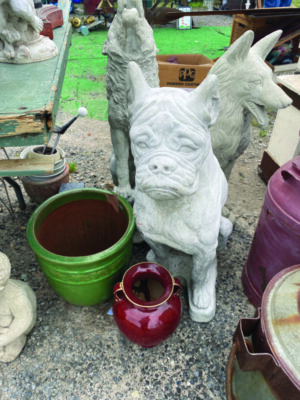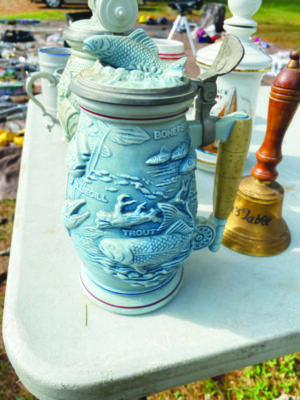Where to spot treasures such as antiques, handcrafted creations, nerf guns, t-shirts, lime trees and a bear trap
By John Fladd
jfladd@hippopress.com
Flea markets generally fall into three categories:
Antiques. This doesn’t necessarily mean snooty people arguing over the fine points of Chippendale armoires, although it can. It means that most items on offer are old: boxes of old books, turn-of-the-last-century bottles, antique car parts, used CDs, piles of vintage Barbie dolls, or a stuffed owl or two — cool old stuff waiting for someone with a particular enthusiasm.
Sweat socks. Not just sweat socks, of course, but inexpensive consumer goods like burner phones, cell phone covers, neon-colored tracksuits and lots of shampoo. If you are looking for a velour blanket with a picture of a matador or a howling wolf on it, this is the place to find it. Please don’t think that I am mocking this type of market. It whispers sweet nothings to my heart.
Overgrown garage sale. You’re never sure what you’ll find at this kind of flea market. Yes, there are a few professional dealers specializing in Pokémon cards, or military surplus, but just as many of the vendors are people who have found themselves with too much of something on their hands — some old, some new — that they want to get rid of. For many of them it’s the getting-rid-of that’s the important thing. A sports family might realize they have 20 years’ worth of hockey gear, skis, football helmets and lacrosse sticks, and decide to flea market it.
About three years ago I found my flea market: the late, lamented Hollis Flea Market. It was an antiques market, full of vintage — stuff. There were some stunning antique clocks for customers with much richer blood than mine, but also any number of commemorative plates, piles of old postcards and, once, a giant pile of 3,600 C-clamps.
Unfortunately, this winter, the owners of the Hollis Flea Market announced that they were closing. This has left me searching for a new flea market.
Not counting yard sales and antiques shows, there are four major flea markets in the area:
Londonderry Flea Market
295 Nashua Road, Londonderry
londonderryfleamarket.com
Open Saturdays and Sundays 8 a.m. to 3 p.m. April through October
Admission $1.50 per person; 60+ and kids under 12 get in free.
The basics: The Londonderry Flea Market is an outdoor market on 30 acres, with up to 300 vendors on a given day. Many vendors do not accept credit cards; it’s a good idea to bring cash. There is an ATM on site. According to the Market’s website, there is a “huge assortment of items to find & buy for home, garden, work, pleasure, personal wants & needs. Make a list of things you’d like to buy before you visit the market. Bring the list with you to shop as the sellers here just may have what you’re looking for! f you don’t see it, ask them as it may just be out of sight.”
Food: There is a concession tent in the center of the market selling burgers, hot dogs, snacks and drinks.

The Londonderry Flea Market is very, very large. There are two halves, one on each side of a fire pond. Many of the vendors work under cover, but at the very back of the flea market there are a number of people selling things from tables. I asked one man in the back who was selling old vinyl records and a seriously intriguing pile of 78s how business was. He said he hadn’t made any sales yet, “but it’s about to rain, and I’m located back here in Siberia.”
One of his neighbors in the back section of the flea market was Stephanie St. Pierre, an enthusiastic world traveler and a maker. She was selling a number of trinkets and antiques from Thailand and Myanmar, but her most fascinating items were four handmade cigar-box banjos. They are a reminder of a brief but intense enthusiasm from a few years ago. Some of the banjos have three strings; some have one.
“I like it,” St. Pierre said. “It’s just fun to play with one string. A diddly-bow, I guess is what they call the ones with one string.” At one point, she made electric cigar-box banjos. “The better ones had pick-ups,” she said. “You could plug them into an amp. I’m not musical, but I had fun going to the flea markets to find all the hardware.”
A 3-foot-tall Barbie doll in a crocheted sweater and miniskirt, concrete garden ornaments — I was distracted from these things by a table full of beads. I was struck by a 2-inch bead — a white porcelain cube with a hole through the center, and what appeared to be blue Chinese characters on the sides.
“What’s the story with this?” I asked the lady selling the beads. She examined it closely for several seconds. “I have no idea what that is,” she confessed. I bought it for a dollar, reasoning that I could tie it to my sword scabbard like a samurai, if I ever got really good at using a sword. It pays to be prepared.
Vincent is the Vinnie of Vinnie’s Uniques and Antiques. Unlike most of the vendors’ stalls, his has a sign. He is a regular; he sells at Londonderry every weekend.
“I look for stuff that nobody else has,” he said. “I want something that they [customers] cannot find anywhere else. If it’s something they’re going to have a hard time finding, I want to have that.” On this particular day, his favorite item was a model ship. “I’m going to tell you, I love this boat. This is a beautiful, beautiful boat,” he said. He pulled aside a tarp to reveal a glass case with a model of a four-masted ship inside. “This guy told me that this ship here burned down and they rebuilt it, but it was never the same ship. There isn’t a kit for this ship, so this ship was made by somebody [who knew it well]. I love my ship.”
Coolest item at the flea market that day: It’s a toss-up between a concrete garden statue of a sad dog and a gold-plated reproduction of a crocodile skull.
What I actually bought: The big Chinese bead and a $5 hockey goalie mask to use in my sword class.
Salem Flea Market (Outside)
20 Hampshire Road, Salem
salemfleamarket.com
Open Saturdays and Sundays 7 a.m. to 4:30 p.m. Year-round
Admission $1; a ticket will allow customers to return during the day
The basics: The number of vendors at the outside market can vary on any given day, depending on the weather, but there are usually 50 to 60. Public restrooms are located inside the building. Almost none of the vendors accept credit cards. An ATM is located on the premises.
According to the Salem Flea Market website, “The Salem Flea Market has been open for business for more than 40 years. We have new and used items, including antiques arriving every week.”
Food: There are two or three concession stands at the entrance to the Indoors Market, as well as vendors selling fresh fruit in the Market itself. One review on the Market’s Facebook page reads, “Corn dogs. Corn dogs. Corn dogs. Corn dogs. Corn dogs.”
There are two parts to the Salem Flea Market: an outdoor market and an indoor one. It might be tempting to consider them as a single unit, but they are so vastly different that it makes sense to consider each on its own merits.
The Outside Market butts right up against the parking lot, and there is a lot going on. It is constantly in motion. It comes closest to being another garage sale-type market, but here the focus is on utility. Some of the vendors sell new items, most sell old ones, but virtually everything is practical. If you are looking for a hand-operated winch with 20 feet of chain, or a used large-screen television, this is the place for you.

Lucas sells kitchen appliances. His tables are covered with blenders, food processors, microwave ovens and smaller kitchen tools. He has a small generator on hand, if any customers want to test out one of the appliances. Lucas doesn’t mind telling where he gets his merchandise. He buys the items from thrift stores, most of which he has a relationship with and will sell them to him by the pound. He cleans them up, if necessary, and resells them. I asked him how much he paid for a random blender. It was clean, new-looking, and looked like it would work well in most kitchens.
“I paid maybe 10 dollars,” he said with a shrug. “I can probably sell it here for 20.” What really jumped out at me was a variable-speed, hand-held immersion blender. I asked Lucas how much he wanted for it, and he said he was willing to let it go for $10.
On any given day, the outside market has anywhere up to a dozen cargo trucks. Most are from clean-out businesses or junk removal companies.
On this day, one vendor’s stock was mostly old, hard-worked lawn mowers and piles of air conditioners. His neighbor had three or four tables of used shoes. Another specialized in bicycles and stereo speakers. Because almost everything at the Outside Market is practical, and given the time of the year, several vendors at the front end of the market were selling garden plants. The people who sell at both Salem markets are from all over the world, so many of the vegetable plants for sale weren’t ones you might find at a local garden center — bitter melons, makrut lime trees and some with labels written in Asian characters.
A vendor named Melissa was beginning to think she might have come to the wrong flea market. She was located at the very back of the lot.
“I’ve got some bathrobes, some nightgowns, some [porcelain] figurines, some luggage,” she said, “a little bit of everything. It’s actually all mine. I’ve been a shopper my whole life and collecting things over the years. I usually sell on Facebook Marketplace, but that’s exhausting!” I asked what she thought her hidden gem was. She said that for the right person, the bisque porcelain figurines would be a satisfying find. “What is it they say? ‘One man’s junk is another man’s treasure?’”
Coolest item at the flea market that day: Two KitchenAid stand mixers. The vendor was looking for $80 for the small one, and even missing its bowl he was confident he could get $140 for the six-quart model.
What I actually bought: Plants — two brightly colored lilies and a large pot of Thai chile pepper plants for a total of $12.
Salem Flea Market (Inside)
20 Hampshire Road, Salem
salemfleamarket.com
Open Saturdays and Sundays 9 a.m. to 4:30 p.m. year-round
Admission: The same $1 ticket.
The basics: Public restrooms are located inside the building. Almost none of the vendors accepts credit cards. An ATM is located on the premises.
Food: There is a small snack bar inside.
The Inside Market in Salem definitely falls into the sweat socks category. As soon as you walk through the door you’re greeted by enthusiastic salsa and mariachi music. Neon-colored T-shirts compete for space with affordably-priced perfumes and colognes. One vendor sells apparently new-looking mattresses still in their plastic.
One stall was filled to the brim with brightly colored Catholic statuary — figures of saints and religious figures of all sizes, religious paintings, and ceramic bowls and flower pots.

The Inside Market has several twisting aisles that branch off unexpectedly. Just when you think you’ve seen most of it, you turn a corner and find a completely new group of stalls. Like almost all the shops, my vote for the coolest one doesn’t have a name above the door. It is about twice the size of other shops, and there are dozens — probably hundreds — of used bicycles hanging from the ceiling. It would be a mistake to think of it as a bike shop, however. The main focus of the business seems to be knives of all kinds and replica swords. Tucked away in a corner are two reproduction helmets, one Spartan and one medieval. Plus the truly impressive number of ceiling bikes.
The chain-link wall of a nearby stall is covered with hundreds of wrestling action figures. A man named Tony runs it with his wife. “I mostly sell Pokémon, wrestling, and action figure toys,” he told me. “That’s all I sell. Well, that and some baseball cards. And football cards — things that people collect.”
Another stall is about half the size of Tony’s and looks for all the world like a storage closet. It is packed full of packages of disposable cups and takeout containers. The owner had stepped out when I visited, so I made small talk with a lady who had come in looking for cups. “This is for a church event tonight,” she told me. “I always come here, and I’ve been coming here since before Covid. I always find what I’m looking for.”
A hand-written sign at another stall nearby read, “Good Quality According to the Price You Pay.”
Coolest item at the flea market that day: A trademark-skirting box of brightly colored toy ponies called Horse Lovely. “THAT BEAUTIFUL HORSE SPREAD YOUR WINGS AND FLY,” the box announced cheerfully.
What I actually bought: Three small resin figurines of babies doing kung fu, for $2 each.
Davisville Flea Market
805 Route 103, Warner
davisvillefleamarket.com
Open Sundays 4 a.m. to 1 p.m. (The website advises visiting between 6 and 11 a.m.) Open May 5 until the last Sunday in October rain or shine.
Admission and parking are free.
The basics: An outdoor market with anywhere from 50 to 150+ vendors. Live music, outdoor toilets.
Food: There is a concession stand that sells cold drinks, coffee, foods and snacks. Frequently there will be food trucks or vendors selling food.
The Davisville Flea Market is an antiques-centered one. A few artists and craftspeople sell their work, but the majority of the vendors sell old items. There are vintage tools, piles of old photographs, and beer steins on offer.
Aiden and Myles are 9 years old. I met them as they stood, spellbound, in front of the Holy Grail for 9-year-old boys: a giant pile of dozens of Nerf guns. Aiden was willing to give me some flea market advice, though he was incredibly distracted. His friend Myles stood next to him, his mouth agape. Aiden picked up a bright orange Nerf machine gun and examined it as he said, “I’m looking for one that has an attachment that can hold a lot of bullets.”
Aiden said that he likes the look of the guns. “If they made these look like camo [camouflage pattern] that would be good, if you’re into that,” he said, “but I like the bright colors. I think they make them this bright, so you buy them more.”

As I walked around to different tables, I was reminded of some lessons about flea market etiquette I’ve learned the hard way. I approached a table under the shade of some trees that was covered with antique tools. The vendor was having a conversation with another man, but in a slow, laconic way, with many pauses. When I was new to flea marketing, I would have used a lull in the conversation as an opportunity to ask a question, but that has rarely worked out well for me. The polite thing to do is wait until the conversation is completely done.
In this case, I waited four or five minutes for the two men to finish their conversation before talking with the vendor.
“How ya doin’ this morning?” he asked. This is a time-tested traditional greeting that indicated that he was willing to talk. I made a friendly but non-committal answer, because being too enthusiastic about anything sets the wrong tone in negotiations like this. I asked him about a hatchet on his ax table. “What’s the story with this?” I asked. (I could have asked him how much he wanted for it, but that could be interpreted as enthusiasm.)
Clearly this was the right thing to ask. He gleefully told me the brand name of the hatchet. Apparently, at least according to him, it was generally used for splitting shakes. At this point a couple of other customers had wandered over, but I was pleased to find that he had made me one half of the old-guy conversation, so he could make the other people wait.
He tried to sell me a bear trap.
I made my way to a tent run by artists Courtney Norton and Matt West. Their business, 7 Glass Studio, specializes in glass work and pyrography — using heat to burn designs into wood or leather. Matt works in low-heat, non-blown glass. Today he was selling extremely life-like glass caterpillars. “The black, yellow and white ones are your traditional monarch colors,” he explained. “The other ones are just fantasy. People like to stick them in their potted plants.”
John Zapollo sells a lot of different things. Today it was mostly books. He was questioning the wisdom of bringing them to the market. “Books have gone way down,” he said with a rueful shake of his head. “Books here at the flea market don’t seem to sell. It seems like more people are looking for tools and stuff to take care of their houses. The antique stuff that I sell doesn’t seem to get a lot of traction.”
The coolest item at the flea market that day: The bear trap.
What I actually bought: Three antique cookbooks from John. The most interesting one was published by the Heinz Corporation in 1939. I paid $1 apiece.






